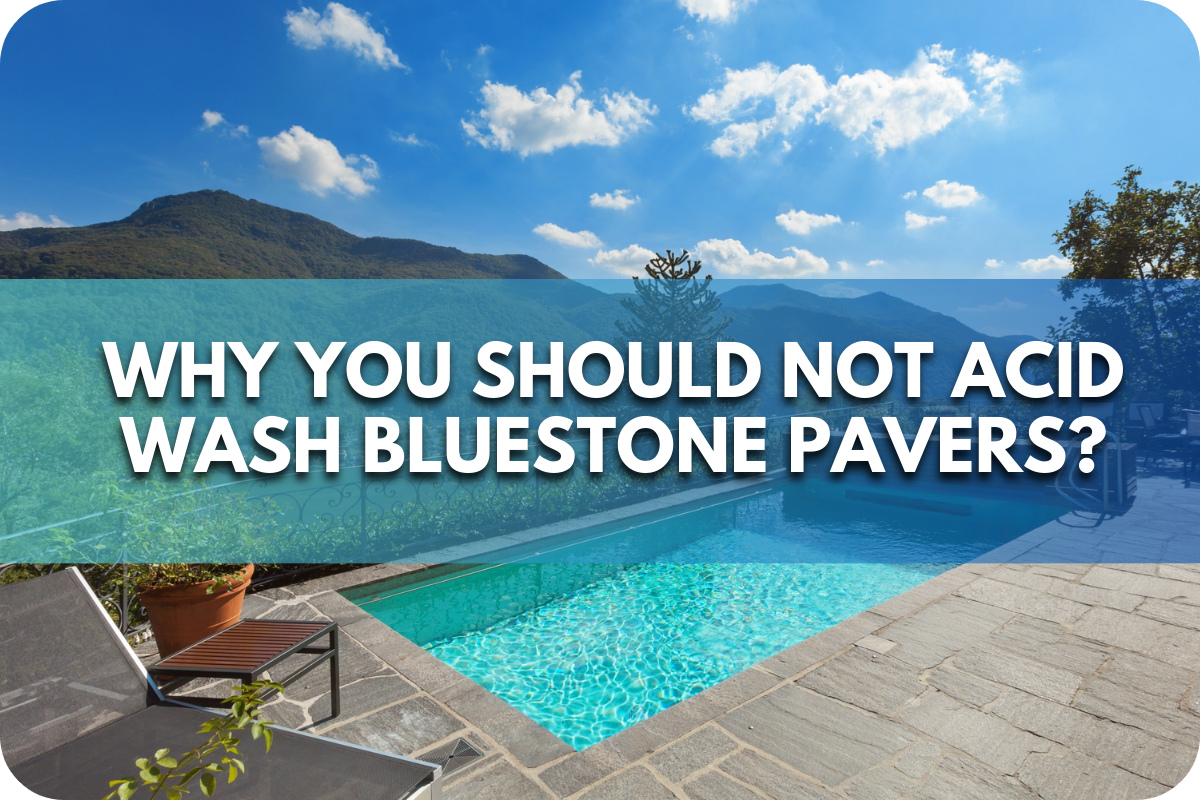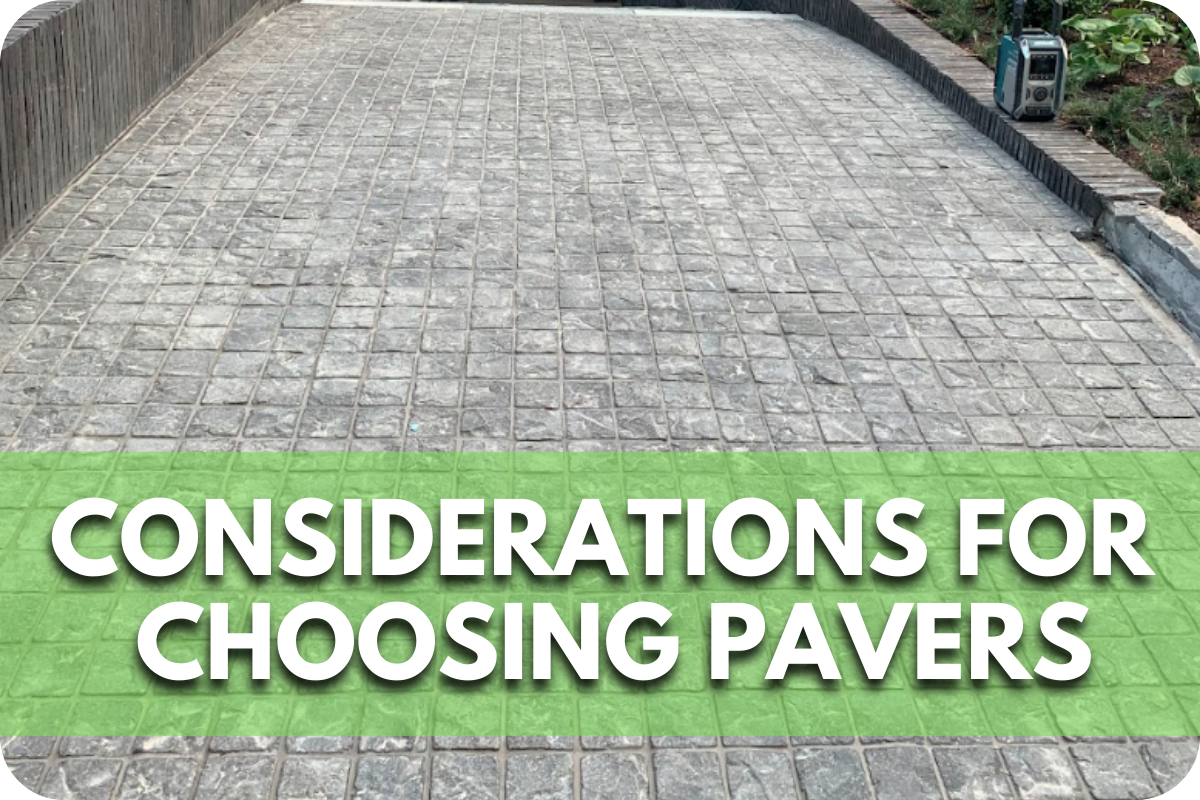
Acid washing is a common method for cleaning bluestone pavers, but it can be harmful.
Using acid on bluestone can erode the stone’s surface, leading to permanent damage and a dulled appearance. This aggressive cleaning technique strips away dirt and the stone’s character.
Instead of risking damage with acid washing, opt for safer, more effective cleaning alternatives that preserve the integrity and beauty of your bluestone pavers. Read on to discover the best practices for maintaining your pavers naturally.
Why You Should Not Acid Wash Bluestone Pavers?
Acid-washing bluestone pavers can cause irreversible damage. Bluestone contains minerals that react with acid, leading to etching, discolouration, and a dull appearance. Opt for pH-neutral cleaners and avoid harsh chemicals to preserve the natural beauty and longevity of your bluestone pavers.
What is Acid Washing?
Acid washing, also known as acid etching, is a cleaning process that involves applying a diluted acid solution to stone surfaces to remove stains, efflorescence (a white, powdery residue), and other contaminants.
This method is often used in installing natural stone to clean and prepare the surface for sealing. It’s commonly employed with materials like concrete and some types of stone that can withstand harsh chemicals.
The process typically involves applying a mixture of hydrochloric acid (muriatic acid) and water directly to the stone. After the solution is allowed to sit briefly to interact with the surface, it is thoroughly rinsed off with water.
This method can be effective for removing stubborn stains and exposing the concrete aggregate for a textured finish.
However, bluestone pavers are particularly susceptible to damage from acid washing. The chemical reaction can cause pitting, roughening of the surface texture, and diminishing of the stone’s natural colour.
Also, improper acid handling can pose safety risks, including skin burns and respiratory issues. Due to these factors, alternative cleaning methods are recommended for bluestone pavers.
The Risks of Acid-Washing Bluestone Pavers
Acid-washing bluestone pavers carry significant risks that can lead to long-term damage and reduced aesthetic appeal. Here are the primary concerns associated with this cleaning method:
- Surface Erosion: Acid solutions can aggressively erode the surface of bluestone pavers. This erosion can lead to pitting and roughening of the surface, making the pavers more susceptible to accumulating dirt and debris in the future.
- Discoloration: The chemical reaction between acid and the minerals in bluestone can alter the natural colour of the pavers. This often results in a faded or uneven appearance, detracting from the stone’s original vibrancy and uniformity.
- Weakening of the Stone: Repeated or overly concentrated acid applications can weaken bluestone, reducing its durability. Weakened pavers are more likely to crack or break under pressure, leading to increased maintenance costs and potentially requiring premature replacement.
- Safety Hazards: Using acid, powerful acids like hydrochloric acid poses significant health risks. It can cause burns to the skin and eyes, and its fumes can irritate the respiratory system, necessitating careful handling and appropriate safety gear.
Types of Outdoor Pavers
When selecting outdoor pavers, it’s essential to consider the variety of materials available, each offering unique benefits and aesthetic qualities. Here are some common types of outdoor pavers:
1. Quartzite:
Quartzite pavers are a top choice for homeowners seeking both durability and natural beauty.
Formed from sandstone under immense heat and pressure, quartzite is exceptionally dense and resistant to wear, making it perfect for high-traffic areas like patios and driveways. It comes in various colours, from subtle whites and creams to dramatic blues and greens, offering multiple design possibilities.
Quartzite is also naturally slip-resistant, enhancing safety around pools and walkways.
2. Porphyry:
Porphyry pavers are known for their distinctive appearance and exceptional durability. This volcanic rock features a fine-grained matrix with larger crystals, creating a unique speckled look.
Available in various shades of grey, red, and purple, porphyry complements both traditional and modern designs. Its strength and resistance to weathering make it an ideal choice for driveways, pathways, and commercial projects.
3. Limestone:
Limestone pavers bring a timeless elegance to outdoor spaces. This sedimentary rock is softer than granite or quartzite, offering a smoother, more refined look.
It comes in neutral tones like beige, cream, and grey, creating a calming and inviting atmosphere. While requiring more maintenance than denser stones, limestone’s natural beauty and versatility make it popular for patios, pool decks, and walkways.
4. Marble:
Marble pavers exude luxury and sophistication. This metamorphic rock is prized for its smooth, polished surface and distinctive veining patterns.
Available in various colours, from classic white to dramatic black, marble adds a touch of opulence to any outdoor space.
While requiring regular sealing and maintenance, marble’s unmatched beauty makes it popular for patios, pool surrounds, and high-end landscaping projects.
5. Granite:
Granite pavers are synonymous with strength and durability. This igneous rock is one of the hardest natural stones, making it incredibly resistant to wear, scratches, and stains.
It comes in various colours and patterns, from speckled greys and blacks to vibrant pinks and blues, offering endless design possibilities.
Granite is excellent for high-traffic areas like driveways, pathways, and commercial projects.
6. Bluestone:
Bluestone pavers are a classic choice for Australian landscapes. This sedimentary rock is known for its beautiful blue-grey hues, natural cleft texture, and exceptional durability.
It complements both traditional and contemporary designs, adding a touch of natural elegance to patios, pool decks, and walkways.
Bluestone is also naturally slip-resistant, making it a safe and practical option for outdoor spaces.
Paver Installation and Maintenance
Proper installation and maintenance are crucial for the longevity and appearance of pavers. Here’s a concise guide:
Installation:
- Preparation: Begin by ensuring a stable base. Excavate the area to about 7-10 inches deep, then fill it with a layer of crushed stone or gravel. Compact this base thoroughly to prevent settling.
- Edging: Install sturdy edging to keep the pavers from shifting.
- Laying Pavers: Start from a corner and work outward. For bluestone and similar materials, use a rubber mallet to set each paver slightly into the base to ensure stability.
- Sanding: Once all pavers are in place, sweep sand over the surface, filling the joints. This helps lock the pavers together.
Maintenance:
- Cleaning: Regular cleaning involves sweeping off debris and washing with a garden hose. Use a mild detergent solution and a stiff brush for tougher stains, avoiding acidic cleaners.
- Weed Control: To prevent weeds, ensure that sand fills the joints completely and consider using a pre-emergent weed inhibitor.
- Sealing: Optionally, apply a sealant to protect the paver’s colour and surface. Natural stones are particularly recommended to enhance their resilience against stains and weathering.
Potential Long-Term Effects
Acid-washing bluestone pavers can lead to several long-term effects compromising the stone’s appearance and integrity. Here are the critical potential long-term effects to consider:
- Surface Erosion: Acidic solutions can etch the surface of bluestone, leading to a rough, pitted texture. This affects the stone’s aesthetic and makes it more susceptible to further damage and staining as the protective layers are worn away.
- Discolouration: Acid washing can significantly alter bluestone’s distinctive colour. The chemical reaction can cause fading or uneven colour patches, detracting from the stone’s natural beauty.
- Structural Weakness: The acid’s chemical reaction can weaken the stone’s structure. Over time, this may increase brittleness and susceptibility to cracking or breaking under pressure or freeze-thaw cycles.
- Increased Porosity: Acid washing can increase the porosity of bluestone, making it more prone to water absorption. This can be particularly detrimental in freeze-thaw environments, where the expansion of frozen water within the stone can lead to cracking and spalling.
- Compromised Sealant: If the bluestone has been sealed, acid washing can strip away the sealant, exposing the stone to stains and weathering effects more quickly than if the sealant were intact.
Alternatives to Acid Washing
When maintaining bluestone pavers, opting for safer, non-damaging cleaning alternatives to acid washing is crucial. Here are some effective methods:
- Soap and Water: A gentle yet effective cleaning solution can be made using mild soap mixed with water. This can remove dirt and mould stains without harming the stone’s surface. Use a soft brush to scrub the pavers gently and rinse with clean water.
- Pressure Washing: Low-pressure washing can be a viable alternative for tougher stains. Using a low-pressure setting is essential to avoid eroding the stone surface. This method effectively removes grime and moss without the use of harsh chemicals.
- Baking Soda Paste: A paste made from baking soda and water can be applied for localised stains. Let it sit on the stain for a few hours before scrubbing gently with a soft brush and rinsing off. This method is perfect for oil and grease stains.
- Vinegar Solution: If slight acidity is needed, a diluted vinegar solution can be a safer alternative to harsher acids. Mix equal parts water and white vinegar and apply it to the pavers. This can help remove mould and mildew without the aggressive effects of stronger acids.
- Commercial Stone Cleaners: Opt for cleaners specifically formulated for natural stone. These products are designed to clean effectively without damaging the stone, ensuring the bluestone retains its natural appearance and integrity.
Considerations for Choosing Pavers
Choosing the right pavers for your outdoor project involves several important considerations to meet your aesthetic goals and performance needs. Here are some key factors to consider:
Material Suitability:
Different materials offer varying levels of durability, slip resistance, and maintenance requirements. For instance, bluestone is highly durable and provides a unique aesthetic but requires specific care to maintain its appearance. Compare materials like concrete, brick, travertine, and granite to determine which best suits your climate and usage needs.
Aesthetic Appeal:
The pavers’ colour, texture, and style should complement your home’s exterior and landscape design. Consider the overall look you wish to achieve—whether modern, rustic, or traditional—and ensure the pavers align with this aesthetic.
Load Bearing Requirements:
Evaluate the expected traffic and load on the pavers. Driveways and parking areas require thicker, more durable pavers than garden walkway ones. Ensure the pavers you choose are suitable for their intended use to avoid premature wear and damage.
Environmental Factors:
Consider local weather conditions such as rain, snow, and temperature extremes. Some materials can withstand freeze-thaw cycles or intense heat without cracking or fading.
Installation and Maintenance:
Understand the installation process and ongoing maintenance required for the pavers you select. Some materials may need regular sealing or specific cleaning methods to retain their appearance and durability.
Importance of Proper Maintenance
Proper maintenance is critical for preserving the longevity and appearance of bluestone pavers. Without regular care, these stones can degrade over time, losing their aesthetic appeal and becoming safety hazards due to uneven surfaces or loose rocks. Here’s why diligent maintenance is essential:
- Preserve Aesthetics: Regular cleaning and occasional sealing help maintain bluestone’s natural colour and texture. This is crucial for keeping the pavers looking new and vibrant, which enhances the overall look of your outdoor space.
- Prevents Damage: Proper maintenance includes regular inspections for any signs of wear, such as cracks or shifts in the pavement. Early detection allows for timely repairs before minor issues become major problems, potentially saving considerable costs in long-term repairs or replacements.
- Enhances Safety: Keeping bluestone pavers in good condition helps prevent tripping hazards like uneven or loose stones. This is particularly important in high-traffic areas where the risk of accidents increases with poor pavement conditions.
- Sustains Value: Well-maintained bluestone pavers contribute to the property’s value. Potential buyers or visitors perceive well-kept outdoor areas as a sign of overall property care, positively impacting property valuation and appeal.
Conclusion
Acid-washing bluestone pavers pose risks that can significantly damage their integrity and appearance. Opt for gentler cleaning methods to preserve your pavers’ beauty and longevity.
Protect your investment by using appropriate maintenance techniques and consulting with a professional for tailored care solutions. With the right care and attention, your bluestone will keep looking pristine.
More To Explore

Limestone vs. Sandstone Pavers: Which is Best for Your Project?
When selecting pavers for your outdoor or indoor spaces, choosing the right material is crucial to achieving both beauty and functionality. Limestone and sandstone are

Is Tuscano Limestone Easy to Maintain?
Tuscano Limestone has become a favourite among homeowners and designers for its timeless beauty and natural charm. Whether used for flooring, countertops, or outdoor spaces,


